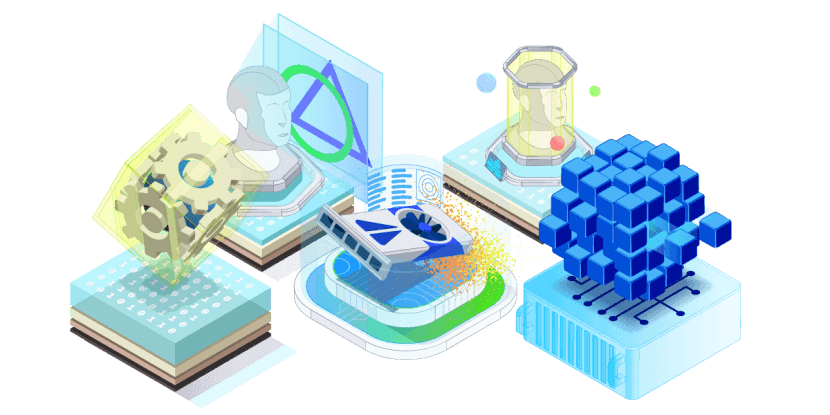What is reinforcement learning?
Reinforcement learning is a fascinating type of machine learning where an agent learns to make decisions by interacting with an environment. Imagine a robot learning to navigate a maze: it tries different paths, receives rewards for getting closer to the exit, and penalties for hitting walls.
Over time, the robot learns the optimal path through trial and error, maximizing its rewards. This process mirrors how humans and animals learn from experience, making reinforcement learning a powerful tool for creating intelligent systems.

Brief explanation of how reinforcement learning works
In essence, reinforcement learning involves a continuous feedback loop between the agent and its environment. The agent takes an action, observes the environment's response, and receives a reward or penalty. This feedback helps the agent learn which actions lead to positive outcomes and which to avoid. The agent's goal is to develop a strategy, called a policy, that maximizes its cumulative rewards over time.
Reinforcement learning has found applications in a wide range of fields, from robotics and game playing to finance and healthcare. Its ability to learn from interactions with complex environments makes it a valuable tool for developing intelligent systems that can adapt and improve over time.
If you understand the fundamentals of reinforcement learning, you'll be well on your way to exploring the exciting possibilities this field has to offer.
Where does reinforcement learning fit into AI and ML?
Reinforcement learning is a distinct subfield of machine learning, alongside supervised and deep learning. While supervised learning relies on labelled data for training and unsupervised learning focuses on discovering patterns in unlabelled data, RL learns through interaction with an environment. An RL agent receives feedback in the form of rewards or penalties, shaping its behaviour to maximize cumulative rewards over time.
RL plays a crucial role in artificial intelligence (AI) by enabling agents to learn and make decisions in complex environments. AI systems aim to exhibit intelligent behaviour, and RL provides a framework for achieving this through trial and error, much like how humans learn. RL algorithms can be incorporated into AI solutions, such as robotics, game playing, and autonomous systems, to develop intelligent decision-making capabilities.
Key Components of Reinforcement Learning
At its core, reinforcement learning (RL) is a framework where an agent learns to make decisions by interacting with an environment. Let's delve into each of these components:
Agent
The agent is the learner and decision-maker in this setup. It could be a robot learning to navigate, a software program mastering a game, or any entity that can perceive its surroundings and take actions.
In RL, the agent's primary goal is to find the best course of action, known as a policy, to maximize a cumulative reward over time. It does this by observing the environment, selecting actions, and receiving feedback in the form of rewards. Through trial and error, the agent refines its policy to make better decisions in the future.
Environment
The environment encompasses everything the agent interacts with. It provides the context in which the agent operates and reacts to the agent's actions by transitioning to new states and providing rewards.
That could be a physical world (like a maze for a robot) or a virtual one (like a game simulator). The complexity of the environment can vary significantly, from simple grid worlds to complex real-world scenarios.
State
The state describes the current situation of the agent within the environment. It's a snapshot that captures all relevant information the agent needs to make a decision.
In a game of chess, the state is the configuration of all pieces on the board. For a self-driving car, the state includes its position, speed, and the surrounding traffic. The state is essential because it provides the context for the agent's actions and helps it understand the consequences of its choices.
Action
Actions are the choices the agent can make to influence the environment. Moving a chess piece or turning the steering wheel of a car are examples of actions. The set of possible actions can be discrete (a limited number of choices) or continuous (a range of values). The agent's ability to select appropriate actions is crucial for achieving its goals and maximizing rewards.
Reward
The reward is the feedback mechanism that guides the agent's learning process. It's a numerical signal that indicates how good or bad an action was in a particular state.
Positive rewards encourage the agent to repeat actions that lead to them, while negative rewards (often called penalties) discourage certain behaviours. The reward signal is a key element in shaping the agent's policy and driving it towards optimal decision-making.
The interplay between these components forms the foundation of reinforcement learning. The agent continuously interacts with the environment, taking actions based on its current state and receiving rewards as feedback. By learning from this feedback, the agent gradually improves its policy, becoming more adept at achieving its goals within the environment.
Types of Reinforcement Learning Algorithms
Reinforcement learning algorithms can be categorized based on several key distinctions, each with its own strengths and weaknesses:
Model-Based vs. Model-Free
The first distinction lies in whether an algorithm explicitly models the environment. Model-based algorithms learn a model of the environment's dynamics, predicting how it will change in response to actions.
This model then guides decision-making, allowing the agent to plan ahead and simulate potential outcomes. Model-free algorithms, on the other hand, directly learn a policy or value function without building an explicit model. They rely solely on experience and the trial-and-error process to improve their decisions.
Value-Based vs. Policy-Based
Another key difference is in how algorithms learn. Value-based algorithms learn a value function that estimates the expected long-term reward for each state or state-action pair.
They then use this function to select actions that maximize expected future rewards. Policy-based algorithms directly learn the policy, a mapping from states to actions. They optimize this policy to maximize the expected cumulative reward.
On-Policy vs. Off-Policy
The way algorithms learn from experience leads to the distinction between on-policy and off-policy methods. On-policy algorithms learn solely from experience generated by the current policy.
This means they must continuously explore and gather new data to improve. Off-policy algorithms can learn from experience generated by a different policy, which allows them to leverage past experience and learn more efficiently.
Deep Reinforcement Learning
Deep reinforcement learning (DRL) combines reinforcement learning with deep neural networks. These networks are powerful function approximators that can learn complex patterns and relationships in high-dimensional data.
DRL has shown remarkable success in solving challenging problems, such as mastering complex games like Go and StarCraft II, and controlling robots in real-world environments.
Each of these categories represents a different approach to reinforcement learning, with its own advantages and drawbacks. Understanding these distinctions is crucial for choosing the right algorithm for a specific task and tailoring it to achieve optimal performance.
Challenges in Reinforcement Learning
Reinforcement learning, despite its impressive achievements, comes with its own set of challenges that researchers and practitioners must address:
Exploration vs. Exploitation
One of the fundamental dilemmas in RL is the trade-off between exploration and exploitation. The agent needs to explore the environment to discover new potentially rewarding actions and states.
However, it also needs to exploit its current knowledge to maximize its reward. Striking the right balance between these two competing goals is crucial. Too much exploration can lead to inefficient learning, while too much exploitation can prevent the agent from finding optimal solutions.
Credit Assignment Problem
The credit assignment problem arises when an agent receives a reward after a sequence of actions. Determining which actions in the sequence were responsible for the reward can be difficult.
Was it the first step that set the stage for success, or was it a later decision that sealed the deal? Assigning credit appropriately is essential for learning effective policies.
Curse of Dimensionality
The curse of dimensionality refers to the exponential growth in the number of states and actions as the complexity of the environment increases. In high-dimensional spaces, it becomes increasingly difficult to represent and learn value functions or policies effectively. This can lead to slow learning, inaccurate predictions, and suboptimal performance.
These challenges highlight the complexities involved in designing and implementing reinforcement learning algorithms. Researchers are actively developing new techniques and approaches to tackle these issues and push the boundaries of what RL can achieve.
Advances in reinforcement learning
One significant area of focus is the development of value- and policy-based methods that do not rely on model assumptions. These methods have revolutionized data processing and analysis, particularly in the finance industry, by enabling improved decision-making in complex environments. The integration of neural networks with RL algorithms has further enhanced their performance, particularly in applications such as game playing and AI training solutions for optimal strategies.
Focusing on real-world implementation
Another critical topic is the application of RL in real-world scenarios, which presents unique challenges. Researchers have identified several key issues that need to be addressed to make RL practical for real-world problems. These include the need for robust and scalable algorithms that can handle the variability and unpredictability of real-world environments. Additionally, the security and privacy of RL systems have become a growing concern, with studies highlighting vulnerabilities that could lead to unreliable or unstable services.
Offline reinforcement learning is also gaining attention as it allows agents to learn from pre-collected datasets, reducing the need for expensive online data collection. This approach is particularly relevant for recommender systems, where large offline datasets are readily available. However, offline RL faces challenges related to data efficiency and the need for robust algorithms that can handle visual distractions and changes in dynamics.
Fusing DRL and GNN
The fusion of deep reinforcement learning (DRL) with other advanced techniques, such as graph neural networks (GNNs), is another emerging topic. This combination aims to enhance the utility and applicability of RL in complex, graph-structured environments, addressing issues like generalizability and computational complexity. Moreover, the deployment of DRL systems across various platforms, including server/cloud, mobile/embedded systems, and game engines, has revealed numerous challenges related to environment interaction and communication.

Applications of Reinforcement Learning
Reinforcement learning's versatility has led to its adoption in a wide range of fields, showcasing its potential to revolutionize how we solve complex problems:
Robotics and Control Systems
RL has emerged as a powerful tool for training robots to perform complex tasks in real-world environments. Robots can learn to walk, grasp objects, and even perform intricate manipulations by interacting with their surroundings and receiving feedback in the form of rewards. This approach enables robots to adapt to dynamic and unpredictable situations, making them more autonomous and capable.
Game Play
RL has garnered significant attention for its successes in game play. Algorithms like AlphaGo and AlphaZero have demonstrated superhuman performance in games like Go, chess, and Shogi, pushing the boundaries of what AI can achieve. RL agents learn optimal strategies by playing against themselves and refining their decision-making through millions of iterations.
Healthcare
In healthcare, RL holds the promise of personalized treatment plans and optimized decision-making. RL algorithms can learn to recommend treatments, adjust drug dosages, and even control medical devices like prosthetics. By analyzing patient data and optimizing for desired outcomes, RL can potentially improve patient care and lead to better health outcomes.
Finance
The financial sector is also exploring the potential of RL. Algorithms can learn to make optimal trading decisions, manage portfolios, and even assess credit risks. RL's ability to adapt to changing market conditions and optimize for long-term gains makes it a valuable tool for financial institutions.
Recommendation Systems
Recommender systems is another area where RL is making an impact. By learning from user interactions and feedback, RL algorithms can personalize recommendations for products, movies, music, and more. This not only enhances user experience but also improves the effectiveness of marketing and advertising campaigns.
Future of Reinforcement Learning
Reinforcement learning (RL) is poised to play an increasingly pivotal role in shaping the future of artificial intelligence and its applications across various domains. Several key trends and advancements point towards a bright future for RL, promising to unlock new levels of autonomy, decision-making capabilities, and problem-solving prowess.
One of the most exciting prospects for RL is the development of algorithms that can scale to increasingly complex environments and tasks. Current RL methods often struggle with high-dimensional state spaces and long time horizons, hindering their applicability in real-world scenarios. However, ongoing research is focused on developing more scalable and efficient algorithms that can tackle these challenges.
Techniques such as hierarchical reinforcement learning, distributed RL, and meta-learning are showing promising results in improving scalability and reducing sample complexity.

As RL becomes more prevalent in real-world applications, ethical and societal considerations will become increasingly important. Ensuring fairness, transparency, and accountability in RL algorithms will be crucial to avoid unintended consequences and biases.
Additionally, addressing concerns about job displacement, privacy, and safety will be essential to ensure the responsible and beneficial deployment of RL technology.
The ultimate goal of many AI researchers is to develop artificial general intelligence (AGI), a system that can learn and perform any intellectual task that a human being can.
While AGI remains a distant aspiration, RL is considered a key component in achieving it. By enabling agents to learn and adapt in complex and dynamic environments, RL provides a framework for developing intelligent systems that can generalize their knowledge and skills to new situations.
Using OVHcloud for Reinforcement Learning
OVHcloud offers a range of services that can significantly assist with reinforcement learning projects:
High-performance computing resources:
RL often requires substantial computational power, especially for training complex models and simulating environments. OVHcloud provides various high-performance computing solutions, including GPU instances and clusters, allowing for faster training and experimentation.
Scalable storage:
RL projects can generate massive amounts of data, such as training datasets, logs, and model checkpoints. OVHcloud's scalable storage options, like object storage and block storage, ensure that you have ample space to store and manage your data efficiently.
Data processing and analytics:
OVHcloud offers tools and services for data processing and analytics, which are essential for analysing training data, evaluating model performance, and extracting insights to improve RL algorithms.
AI & machine learning tools:
OVHcloud provides a suite of AI and machine learning tools and services, such as AI Notebooks and AI Training, that can simplify the development and deployment of RL models. These tools can streamline the process of building and training RL agents, reducing the time and effort required.
Flexible infrastructure:
OVHcloud's cloud infrastructure is flexible and adaptable, allowing you to scale your resources up or down as needed for your RL project. This ensures that you only pay for the resources you use, optimizing costs and resource utilization.
Broadly-speaking, OVHcloud's comprehensive suite of services can provide a robust foundation for reinforcement learning projects. By leveraging OVHcloud's infrastructure, tools, and support, you can focus on developing and refining your RL algorithms, accelerating your research and development efforts, and achieving your project goals more efficiently.
OVHcloud and reinforcement learning

AI Deploy
Easily deploy machine learning models and applications to production, create your API access points effortlessly, and make effective predictions.

AI Training
Train your AI, machine learning and deep learning models efficiently and easily, and optimise your GPU usage.

